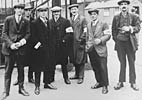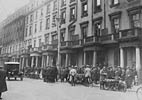The National Strike began on 3 May. The strikers' newspaper published by the TUC, 'The British Worker', was at great pains to argue that workers 'must not be misled by Mr. Baldwin's attempt to represent the present struggle as a political one'. Workers on the 'Daily Mail' refused to print a leading article denouncing the strike under the banner headline 'For King and Country'. Negotiations continued, including secret talks between the TUC Negotiating Committee and Herbert Samuel, chair of the 1925 Royal Commission. These resulted in the Samuel Memorandum - the so-called formula which was used to end the strike.
The strike received overwhelming support, despite the carefully laid plans of the OMS. This success was due in large measure to the work of Trades Councils and Councils of Action. All such activities were accomplished in the teeth of police harassment and mass arrests, with the armed forces strategically positioned close to suspected 'trouble spots'.
However, much to the surprise of the participants, and to the shock of the miners, the acceptance by the TUC of the Samuel Memorandum was used as the formula for a 'settlement' and the strike was called off after 9 days. In fact, the Memorandum settled nothing. It was merely a re-jigging of the proposals of the 1925 Royal Commission with the difference that the Memorandum made vague the former's more explicit demands for wage reductions.
Professor Mary Davis, Centre for Trade Union Studies, London Metropolitan University
Click on a link below to view pictures, documents and newspapers charting the course of the nine days of the General Strike.
4 May 1926
5 May 1926
6 May 1926
7 May 1926
8 May 1926
9 May 1926
10 May 1926
11 May 1926
12 May 1926









